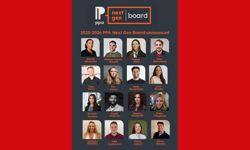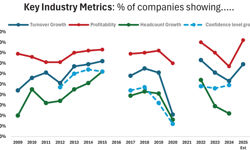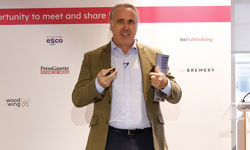Advertising has been in the frontline of the digital revolution, from the need to create compelling social media content to the shock of ad-blocking. So it comes as little surprise that Campaign, for decades dubbed ‘the ad industry’s bible’, has had to reinvent itself to keep pace.
One of the biggest changes spurring on its publisher, Haymarket, is the breaking down of the barriers that once existed between the different professional disciplines making up the advertising industry. In response, from May, the company brought all of the titles that address these once diverse sectors – Marketing, Brand Republic and Media Week – under the banner of Campaign, with a revamped website, campaignlive.co.uk.
Supporting creativity
The relaunch was accompanied by a humorous advert created by adam&eveDDB around the theme of ‘Proud Parents’, highlighting Campaign’s role in nurturing the new breed of creative brand builders crossing the traditional disciplines.
Longstanding editor-in-chief Claire Beale, who worked with new UK editor Rachel Barnes on the redesign, admits: “There’s no doubt there’s a challenge for us in serving a bigger, broader audience. We’re keeping our focus on championing creative excellence and holding a critical mirror up when we think work is produced that’s not good enough.”
The award-winning #LikeAGirl campaign created for Proctor & Gamble’s Always sanitary-care brand by Leo Burnett, which was viewed 90m times worldwide and helped to reclaim ‘Like A Girl’ as a positive statement, is an example of the sort of creative excellence Beale and her team want to promote.
There have been no job losses as a result of the merger of titles, rather there has been an investment in technology and getting the right people on board, including hiring Gideon Spanier from The Times as head of media, as well as improving the analytics and development capabilities of the team.
Solving business problems
Global brand director Adrian Barrick, who came to Campaign from a background in reinventing brands at B2B publisher UBM, explains: “The people who really get it are the people who are solving business problems rather than communication problems. They are the people who are harnessing all the creative tools that are out there to find ways of cutting through the noise and delighting consumers, persuading them to connect with their brands. The new breed is not 25-year-olds with asymmetrical haircuts; it’s people who think like that whether they’re 25 or 55.”
He adds: “I can’t think of an area of this world that hasn’t been disrupted in the last ten years by data, by software, by the changing nature of consumers and the rise of the millennial generation. The very clear demarcations that may have existed a few years ago are breaking down and that has meant that having a set of brands that address those niches is no longer as relevant as being able to offer content and insight to the whole community.”
When Campaign launched in 1968, it was aimed at the whole of the marketing, advertising and media industry; it was only after a number of acquisitions that it became more narrowly focused on ad-land. So, in some ways, in its latest incarnation, the title has come full circle.
There is also the more prosaic argument that Campaign was the only one of Haymarket’s media titles with a significant, albeit small, paid-for print circulation of 6-7,000. Now, Marketing’s controlled circulation has been added to this, doubling the new umbrella title’s circulation to around 15,000, with separate but complementary weekly and quarterly print editions. Although the future of the business lies in digital and live activities, Barrick insists Campaign remains “platform agnostic”: “We’ll distribute our content to people wherever they want it in whatever format they want. As readers still want to buy a weekly magazine, we are more than happy to produce it.”
Work in progress
The strategy took eighteen months to put together, and is still a work in progress. “We are testing and will evolve it for ever,” says Barrick. Haymarket chose to tell its readers what it was planning in advance. “We were taking a bit of a risk because we were showing our hand to our competitors, but what was more important than worrying about whether someone was going to steal our brilliant ideas was our relationship with our audience and our commercial partners.”
Of course, print is only one element. Media Week went digital-only in 2009 and Brand Republic has been digital since it launched in 2001. Campaignlive.co.uk works on an FT-style subscription model whereby the first three articles are free, then you are asked to register to receive a further ten free articles, before you must pay to access content, although these access settings are reviewed all the time. The new website is organised into hubs offering targeted news for Brands, Agencies and Media. Brands is currently described as ‘powered by Marketing’, while Media is ‘powered by Media Week’ and, according to Barrick, these sub-headings will remain “as long as the audience want it… there is still a residual affection [for them].” Campaign’s total social media reach is about 900,000 and when you register for the site, you are asked to provide preferences to allow targeted newsletters to be delivered daily to your inbox.
Events
Events are an increasingly important revenue stream for Campaign, which has just hosted the Media360 conference in Brighton looking at the future of media in a disrupted world. An Asian version of the conference will be held in Hong Kong next February, while the title is also partners with Spikes Asia, the biggest advertising and marketing festival in Asia, which takes place in Singapore in September. Haymarket will continue to host the popular Media Week awards, despite the disappearance of the brand as a standalone title and it also holds smaller bespoke events described as ‘content labs’. According to Beale, “we provide a focal point. Across all of our platforms and live events and awards, we are very much the industry coming together to be collectively better. It’s not just stories, analysis pieces and features, it’s soliciting and offering a place for debate.”
Global reach
There are now eight Campaigns around the world, covering the UK, Asia, India, Turkey, the Middle East, the US and, most recently, Japan and China. It is Beale’s job to look for ways to amplify the benefits of being a brand that produces content in eight territories, from sharing stories to collaborating on the development of those stories. “These are thriving advertising markets where we see a gap for the product that we produce. Campaign as a brand was a global currency even when it was UK-only so that’s made it a lot easier for us to put this strategy in place, because whatever territory we go in, senior people will have heard of us, will have an aspiration to engage with us,” she reveals. As its audience becomes more internationally-networked, the brand is increasingly dealing with the local offices of the same companies in its different territories, both commercially and in terms of readership, with the next step being to offer global subscription packages. But Barrick is adamant that Campaign will run separate websites in each of its territories for the foreseeable future: “The research we’ve done says our audiences value the local above the global for now, but increasingly we’re developing the same user experience in those different territories.”
The US market
While the UK, with nearly half a century of history to build on, accounts for about two thirds of Campaign’s business, in the US, where it launched two years ago, the title occupies a very different space in the market, up against big beasts such as Advertising Age and Advertising Week. Barrick reveals: “In the US, we’re trying to do something different because we’re new and because we’re smaller than our rivals, it means our mindset is different, whereas in the UK and Asia, we have a leadership role, we’ve got to behave differently. That’s fun, it creates opportunities to learn.” The title already has the most online traffic of all Haymarket’s brands in the US. “We’ve got a good and a growing team out there and they’ve really started to make some waves,” boasts Barrick. “We’ve really started to poke a stick at issues like gender diversity, a huge issue in the US right now, where it’s very much a white male middle class industry, and have been quite punchy in our coverage. That’s given us not just a following but an identity as well. We’re in a position there to tackle issues some of the incumbents feel a bit queasy about taking on.”
Ad-blockers
Ad-blocking is a problem for advertisers everywhere, and Beale does not shy away from the topic: “It’s a massive issue of course because if people are choosing not to look at the communications you’re trying to put in front of them, you’re going to have to pack up and try something else altogether.” She believes there is a big job for the industry to highlight to consumers the value of the exchange between advertising and quality content. “Without the advertising, the content which they are trying to consume wouldn’t even be there. That’s one important factor that we need to keep pushing home.” But she adds: “Frankly if the industry is producing work that isn’t useful, informative or entertaining to people, then we have to share some of the blame for them wanting to turn it off. It’s a call to arms for everyone to up their game.”
The next big issue for the advertising industry, and consequently for Campaign, will be client companies becoming affected by the shift to online and mobile. “That’s the next wave,” predicts Beale, “how advisers and strategists working on brands deal with disruption in their client industries. It’s just going to snowball.”












